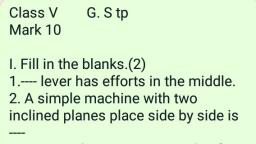Page 1 :
D SIMPLE MACHINES, , There are six types, of simple machines:, @ Lever, , @ Pulley, , @ Inclined plane, , @ Screw, , @ Wheel and axle, , @ Wedge, , Lever, , How would you feel if you returned tired and hungry and had to ‘open’ the, door by lifting or knocking it down? This problem is solved by fixing the door, on hinges. The entire door is a simple machine called the lever., , A lever is any simple machine that turns around a fixed point. There are, , three parts of a lever. The turning point or the point of support Is called the, fulcrum, the object to be moved is called the load and the force applied to, the object is called effort. Levers can be classified on the basis of the position, of the fulcrum, load and effort., , First class lever: When the fulcrum is between the load and effort, it is a first, class lever. Examples are scissors, claw hammer, pliers, see-saw, etc., , Second class lever: When the load is between the fulcrum and the effort, it is called, a second class lever. Examples are wheelbarrow, bottle opener, nutcracker, etc., Third class lever: When the effort is between the fulcrum and the load, it is a, third class lever. Examples are ice tongs, fishing rod, nail clippers, etc., , The closer the fulcrum and the load, the lesser is the effort. That is why a tall, narrow door swings open more quickly than a wide garden gate. Here are the, three classes of levers: E stands for effort, L for load and F for fulcrum., , , , First class lever Second class lever Third class lever, Mae 0 Hi. ‘A, [BSS NG RUINS URE ORE a a Ee, , Ar, , fulcrum

















































